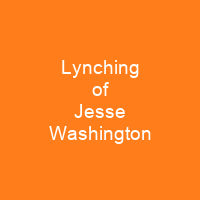The Tragic Lynching of Jesse Washington: A Dark Chapter in American History
Imagine a scene so horrific that it defies description—a young man, Jesse Washington, hanged and mutilated by an angry mob in the heart of Waco, Texas. This was not just a crime; it was a spectacle, a public execution that left over 10,000 spectators in awe or horror, depending on their perspective.
Was Jesse Washington truly guilty? Or did he become a scapegoat for the racial tensions of his time? These questions linger even today as we revisit this dark chapter in American history. The lynching of Jesse Washington was not just an isolated incident but a pivotal moment that shaped public opinion and activism against such barbaric acts.
The Lynching: A Public Spectacle
In the early morning hours of May 15, 1916, Jesse Washington, a 17-year-old African American farmhand, was dragged from his jail cell in Waco. The mob, fueled by rumors and racial hatred, paraded him through the streets before hanging him from a tree in front of city hall. The event was not just a crime but a public spectacle, with thousands of people watching as he was beaten, stabbed, and burned alive.
How could such an atrocity occur in a city that prided itself on its progressive image? Waco, despite its black middle class and two black colleges, had a dark underbelly of racial tension. The lynching of Sank Majors in 1905, just a decade earlier, foreshadowed the horrors to come.
The Aftermath: A Nation’s Response
When news of Jesse Washington’s lynching spread across the nation, it sparked outrage and condemnation. Newspapers that had previously defended such acts now condemned them, but local officials tried to downplay the event as a small group of malcontents gone wild.
The National Association for the Advancement of Colored People (NAACP) took up the cause, publishing a special issue of their newsletter titled ‘The Waco Horror.’ This publication included graphic images and accounts that shocked readers. The NAACP’s efforts helped shift public opinion against lynching, making it more than just a local problem but a national scandal.
The Legacy: A Turning Point in History
While the lynching of Jesse Washington was horrific, it also marked a turning point. It brought attention to the issue of racial violence and helped galvanize efforts against such acts. The NAACP’s campaign against lynching not only raised awareness but also contributed to the decline of these brutal practices.
The event is now commemorated with a historical marker in Waco, symbolizing both remembrance and atonement for past wrongs. As we look back on this tragic chapter, it serves as a reminder of the ongoing struggle for justice and equality.

The lynching of Jesse Washington was a defining moment in the history of racial violence, marking both a nadir and a turning point. It serves as a stark reminder that while progress has been made, the fight for justice and equality remains ongoing.
You want to know more about Lynching of Jesse Washington?
This page is based on the article Lynching of Jesse Washington published in Wikipedia (retrieved on November 30, 2024) and was automatically summarized using artificial intelligence.







